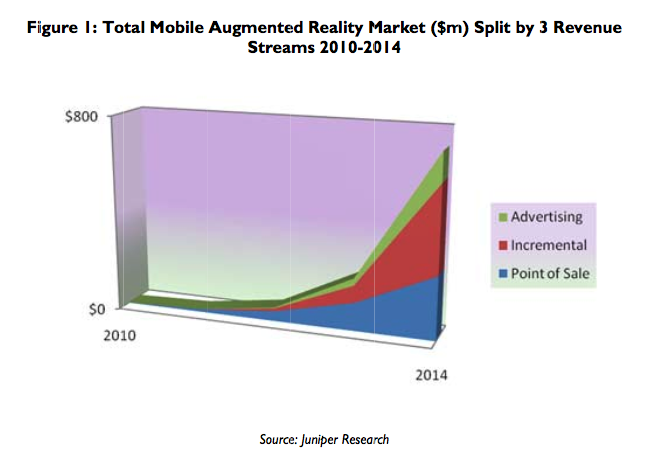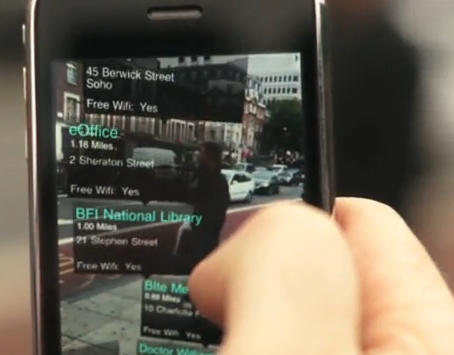
 Hype around augmented reality, a technology that can superimpose graphics or information over the real world in your phone’s viewfinder, is at a fever pitch. But can it deliver the revenues?
Hype around augmented reality, a technology that can superimpose graphics or information over the real world in your phone’s viewfinder, is at a fever pitch. But can it deliver the revenues?
Around two dozen applications like Layar, Junaio and Wikitude have burst onto iPhone and Android devices. (If you’re curious about how augmented reality looks and feels, see the video I’ve embedded below. It’s kind of like looking at the world through Terminator vision.)
Now Juniper Research is saying the market could grow to $732 million in five years, from just under $2 million next year. ABI Research has a more modest estimate: $350 million in annual revenues by 2014. That’s on the back of three primary revenue models: upfront payments to buy an app, subscription fees or paid premium versions and advertising.
The first two are self-explanatory, and might work well with augmented reality games. Advertising could take several forms. You might see augmented reality coupons or sponsored information tags as location-based services become more adept at serving ads based on your historical search needs and where you are. A couple of augmented reality browsers like Acrossair’s Nearest Tube or Layar could incorporate sponsored layers. For example, Starbucks could pay to add a special augmented reality layer to an existing browser showing nearby coffee spots. Or it could buy access to the technology to build its own app.
 But there are reasons to remain skeptical. Venture capital firms have been relatively reluctant to back these young companies — Amsterdam-based Layar is the only company in the last three months to announce a round of venture funding. The larger and older businesses, Metaio and Total Immersion, are launching mobile products on the back of the businesses they’ve already built through augmented reality marketing and factory layout projects from the past. (See an example here.)
But there are reasons to remain skeptical. Venture capital firms have been relatively reluctant to back these young companies — Amsterdam-based Layar is the only company in the last three months to announce a round of venture funding. The larger and older businesses, Metaio and Total Immersion, are launching mobile products on the back of the businesses they’ve already built through augmented reality marketing and factory layout projects from the past. (See an example here.)
There are also a number of design issues still to be overcome. The use case is physically uncomfortable. It can be easier to look something up in a conventional map application than to constantly hold your phone at eye-level to see augmented reality tags.
The second issue is that augmented reality is still a bit of a novelty or a gimmick (see Metaio’s app to the left where you can insert 3D objects into your camera viewfinder).
And then of course there’s the business hurdle of reaching critical mass so that an advertising model can sustain a service. That said, Layar is boasting some promising statistics. The company said it has close to half a million downloads and the app is sticky with users logging in about 6.7 times a week on average.
So if Layar’s adoption (and those of its competitors) continues accelerating upward, stay tuned.
VentureBeat's mission is to be a digital town square for technical decision-makers to gain knowledge about transformative enterprise technology and transact. Learn More

